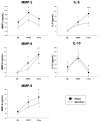Differential effects of epsilon-aminocaproic acid and aprotinin on matrix metalloproteinase release in patients following cardiopulmonary bypass
- PMID: 18427286
- PMCID: PMC2666004
- DOI: 10.1097/FJC.0b013e318168400a
Differential effects of epsilon-aminocaproic acid and aprotinin on matrix metalloproteinase release in patients following cardiopulmonary bypass
Abstract
This study examined whether differential effects of 2 agents commonly used for hemostatic purposes during cardiac surgery, aprotinin and epsilon-aminocaproic acid (EACA), exist with respect to elevations in proinflammatory interleukins (ILs) and matrix metalloproteinases (MMPs) in patients undergoing coronary artery bypass surgery. Sixty patients were prospectively randomized to receive either aprotinin (1 x 10 KIU; n = 30) or EACA (5 g IV; n = 30), and blood samples were obtained for IL and MMP levels just before induction of anesthesia (Baseline), 10 minutes after separation from cardiopulmonary bypass (Post), and 6 hours after surgery (6 hours). IL-6 was increased at Post in the EACA group and increased further at 6 hours. In the aprotinin group, IL-6 was significantly increased only at 6 hours. MMP subtypes associated with inflammation, MMP-8, and MMP-9 were increased in the EACA group at Post and remained elevated at 6 hours. Thus, differential effects on IL and MMP release occurred between aprotinin and EACA, indicative of different mechanisms of action independent of hemostatic effects.
Figures

References
-
- Spinale FG. Matrix metalloproteinases. Regulation and dysregulation in the failing heart. Circ Res. 2002;90:520–530. - PubMed
-
- Visse R, Nagase H. Matrix metalloproteinases and tissue inhibitors of metalloproteinases: structure, function, and biochemistry. Circ Res. 2003;92:827–839. - PubMed
-
- Newby AC. Matrix metalloproteinases regulate migration, proliferation, and death of vascular smooth muscle cells by degrading matrix and non-matrix substrates. Cardiovasc Res. 2006;69:614–624. - PubMed
-
- Li J, Schwimmbeck PL, Tschope C, Leschka S, Husmann L, Rutschow S, Reichenbach F, Noutsias M, Kobalz U, Poller W, Spillmann F, Zeichhardt H, Schultheiss HP, Pauschinger M. Collagen degradation in a murine myocarditis model: relevance of matrix metalloproteinase in association with inflammatory induction. Cardiovasc Res. 2002;56:235–247. - PubMed
-
- Wilson EM, Moainie SL, Baskin JM, Lowry AS, Deschamps AM, Mukherjee R, Guy TS, St John-Sutton MG, Gorman JH, 3rd, Edmunds LH, Jr., Gorman RC, Spinale FG. Region- and type-specific induction of matrix metalloproteinases in post-myocardial infarction remodeling. Circulation. 2003;107:2857–2863. - PubMed
Publication types
MeSH terms
Substances
Grants and funding
LinkOut - more resources
Full Text Sources
Other Literature Sources
Miscellaneous

